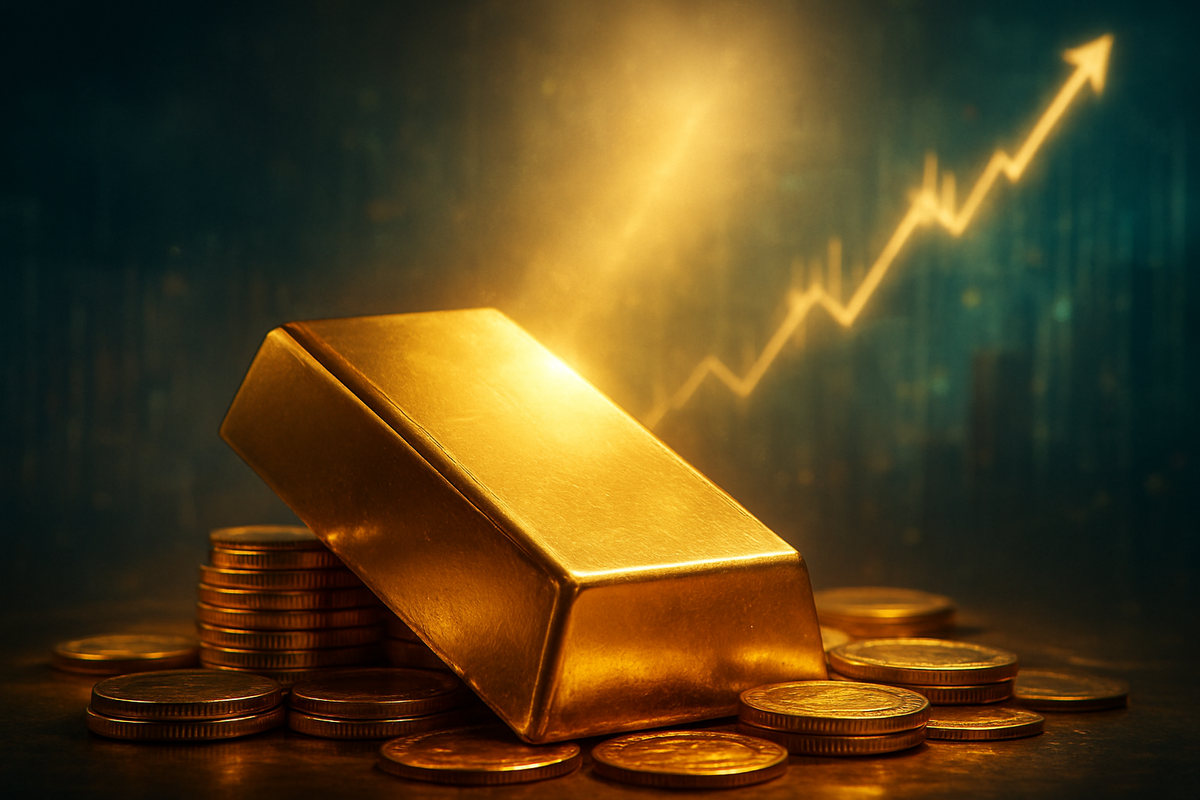
Gold is currently experiencing a robust and significant bullish momentum, marked by a powerful rebound from critical support levels and a technical outlook that strongly suggests a continued ascent toward unprecedented price levels. As of November 11, 2025, the precious metal is not just gaining ground but is poised to challenge and potentially surpass its previous all-time highs, fueling considerable excitement and speculation across global financial markets. This surge is largely underpinned by a confluence of macroeconomic factors, including anticipated shifts in Federal Reserve policy and growing concerns over the health of the US economy.
The immediate implications of this rally are substantial, signaling a potential shift in investor sentiment towards safe-haven assets amidst a landscape of evolving economic uncertainties. Gold's renewed strength is drawing attention from both institutional and retail investors, who are closely watching its trajectory as a barometer for market stability and a hedge against inflation. This upward trajectory could redefine portfolio strategies and influence monetary policy discussions in the coming months, as the world grapples with the implications of a strengthening gold market.
The Golden Ascent: A Timeline of Resilience and Rally
Gold's recent performance has been nothing short of spectacular, demonstrating remarkable resilience and a decisive break from previous consolidation phases. The yellow metal initiated the current trading week with a sharp upward trajectory, climbing approximately 2% and settling near the $4100 per ounce mark. This impressive run follows a significant rebound on November 10, where gold surged nearly 2%, or roughly $80 per ounce, to reach $4,078.45. This rebound is particularly noteworthy as it occurred after a "flash crash" in October 2025, which saw gold correct almost 10% from its then all-time high of $4,381.58.
The timeline leading up to this bullish moment highlights gold's technical strength. The precious metal had fallen into "oversold" territory after the October correction, setting the stage for an upward reversal. It successfully broke out of a recent consolidation phase, pushing decisively above the swing high around the $4,150 level and surpassing a key resistance area at $4100.00. Crucially, a critical support band between $4,000 and $4,027, with the $4,050 area now acting as a fresh support zone, has held firm. The 61.8% Fibonacci retracement level at $3,953 proved to be an indispensable anchor, stabilizing prices for several trading days before the current breakout.
Key players driving this market sentiment include central banks, particularly the People's Bank of China, which has consistently added to its gold reserves for the twelfth consecutive month as of October. This sustained institutional demand provides a strong foundational element to the bullish outlook. Furthermore, expectations of a Federal Reserve interest rate cut in December 2025, with probabilities ranging from 60% to 64%, are significantly influencing market reactions. Lower interest rates reduce the opportunity cost of holding non-yielding assets like gold, enhancing its attractiveness.
Initial market reactions have been overwhelmingly positive, with analysts from major financial institutions revising their price targets upwards. J.P. Morgan Private Bank (NYSE: JPM) forecasts gold prices to top $5000 by 2026, potentially reaching $5,200-$5,300. Goldman Sachs Group (NYSE: GS) maintains an optimistic outlook, anticipating gold to hit $4,900 by the fourth quarter of 2026, while UBS (NYSE: UBS) projects a 12-month price forecast of $4200, with a potential additional $500 surge under significant geopolitical and financial market risks. The widespread "Strong Buy" signals from technical analyses further underscore the prevailing bullish sentiment.
Market Movers: Companies Poised to Win or Lose
The sustained bullish momentum in gold prices is set to create distinct winners and losers across various sectors, with mining companies, precious metal retailers, and even certain financial institutions feeling the ripple effects. Companies directly involved in gold extraction and production are, perhaps, the most immediate beneficiaries. Gold mining giants such as Barrick Gold Corporation (NYSE: GOLD), Newmont Corporation (NYSE: NEM), and AngloGold Ashanti (NYSE: AU) are expected to see significant boosts to their revenues and profitability as the value of their primary product increases. Higher gold prices translate directly into improved margins, allowing these companies to invest more in exploration, expand existing operations, or return capital to shareholders through dividends and buybacks. Junior mining companies and exploration firms also stand to gain, as higher gold prices make previously uneconomical deposits viable, attracting new investment and potentially leading to significant discoveries.
Beyond the miners, companies specializing in precious metal refining, trading, and retail will also experience a surge in activity. Firms like Johnson Matthey (LSE: JMAT), which provides precious metal services, and various bullion dealers and coin retailers, will likely see increased demand for their products and services. Exchange-Traded Funds (ETFs) backed by physical gold, such as the SPDR Gold Shares (NYSEARCA: GLD) and iShares Gold Trust (NYSEARCA: IAU), are already witnessing substantial inflows as investors seek direct exposure to gold's price appreciation without the complexities of physical storage. The asset managers behind these ETFs, therefore, stand to benefit from increased assets under management and associated fees.
Conversely, the impact on other sectors could be less favorable. Industries that use gold as a key input, such as jewelry manufacturers and certain high-tech electronics companies, might face increased production costs. While some of these costs can be passed on to consumers, persistent high gold prices could squeeze profit margins, especially for companies operating in competitive markets. Luxury goods retailers, for instance, might need to adjust their pricing strategies or explore alternative materials to mitigate the impact of rising gold costs. Furthermore, in a broader economic context, if gold's rally is indicative of underlying inflation or economic instability, companies reliant on consumer spending or stable economic conditions could face headwinds. Financial institutions heavily invested in assets that underperform during periods of high inflation or economic uncertainty might also see a negative impact on their portfolios.
Finally, the rising gold price could also influence the lending landscape for mining projects. Banks and financial institutions that provide financing to gold miners might find these projects more attractive due to improved profitability prospects, potentially leading to an increase in specialized lending activities. However, for those institutions with significant exposure to fiat currencies or other assets that tend to weaken against gold in times of economic stress, the overall portfolio performance could be a mixed bag. The interplay between gold's strength and broader market sentiment will dictate the ultimate winners and losers in this evolving financial environment.
Wider Significance: A Barometer of Global Economic Health
Gold's current bullish surge extends far beyond mere commodity trading; it serves as a potent barometer for broader industry trends, global economic anxieties, and potential shifts in monetary policy. This event fits squarely into a historical pattern where gold gains prominence during periods of economic uncertainty, inflationary pressures, or geopolitical instability. The sustained demand from central banks, particularly from emerging economies, underscores a broader trend of de-dollarization and a desire to diversify national reserves away from traditional fiat currencies, reflecting a lack of confidence in the long-term stability of the global financial system. This strategic pivot by sovereign entities is a significant endorsement of gold's enduring value as a safe-haven asset.
The ripple effects of this gold rally are likely to be felt across various markets. Competitors in the safe-haven asset space, such as government bonds, might see reduced demand if investors perceive gold as a more reliable store of value, especially in an environment of anticipated interest rate cuts. Conversely, other precious metals like silver and platinum could experience a sympathetic rally, as investors often look to the broader precious metals complex during gold bull markets. The energy sector, particularly oil, might also see correlated movements, as both commodities are often viewed as hedges against inflation and geopolitical risk. However, the strength of this correlation will depend on the specific drivers of gold's rally – whether it's primarily inflation-driven or risk-aversion driven.
Regulatory and policy implications are also significant. If gold's ascent is indeed driven by concerns over the US economy and expectations of Fed rate cuts, it could exert pressure on central banks globally to reassess their monetary policies. A weaker US dollar, often associated with a stronger gold price, could impact international trade balances and make imports more expensive for the US, potentially fueling domestic inflation. Policymakers might face increased scrutiny regarding their handling of economic data and their forward guidance on interest rates, as market participants increasingly look to gold as an indicator of future economic conditions.
Historically, gold has demonstrated its safe-haven appeal during crises such as the 2008 financial crisis and the early stages of the COVID-19 pandemic. The current situation, with its blend of anticipated monetary easing, economic data concerns, and persistent geopolitical tensions, draws parallels to these past events, reinforcing gold's role as a reliable hedge. The longest government shutdown in US history, mentioned in prior research, adds another layer of political uncertainty that historically bolsters gold's appeal. The consistent accumulation by central banks, especially China's, also harks back to periods when nations sought to bolster their economic independence and resilience against global shocks. This long-term, institutional confidence in gold provides a robust fundamental underpinning to the current bullish trend, suggesting that this is more than just a fleeting speculative rally.
What Comes Next: Navigating the Golden Horizon
The path ahead for gold is fraught with both immense opportunities and significant challenges, offering a range of potential scenarios for investors and market participants. In the short term, the immediate focus will be on whether gold can sustain its breach of key resistance levels, particularly around the $4160-$4200 zone. A successful consolidation above these marks could pave the way for a rapid ascent towards the $4300 level and a retest of its previous all-time high of $4,381.58. Technical indicators, including the 14-day Relative Strength Index (RSI) and MACD lines, suggest continued upward momentum, but market participants will be keenly watching for any signs of profit-taking or a reversal in the US Dollar's trajectory.
Looking further out, the long-term possibilities for gold appear exceptionally bright, with major financial institutions projecting unprecedented price levels. J.P. Morgan Private Bank's (NYSE: JPM) forecast of gold topping $5000 by 2026, potentially reaching $5,200-$5,300, and Goldman Sachs Group's (NYSE: GS) anticipation of $4,900 by Q4 2026, underscore a widespread belief in gold's sustained appreciation. These projections are predicated on continued Federal Reserve easing, persistent central bank demand, and ongoing global economic and geopolitical uncertainties. Should these factors intensify, gold could easily surpass even these lofty targets, entering truly uncharted territory.
Potential strategic pivots or adaptations will be required across various sectors. Mining companies will need to evaluate their capital expenditure plans, potentially accelerating exploration and development projects to capitalize on higher prices. Investors, on the other hand, might need to re-evaluate their asset allocation strategies, considering a higher weighting for gold and gold-related assets to hedge against inflation and market volatility. Market opportunities may emerge in derivatives markets, with increased trading in gold futures and options, as well as in specialized gold investment vehicles. However, challenges such as potential regulatory interventions to curb speculative excesses or a sudden shift in central bank policies could introduce volatility.
Several scenarios could unfold. A "soft landing" for the US economy, combined with gradual Fed rate cuts, could lead to a steady, sustained climb for gold. Conversely, a more severe economic downturn or an aggressive easing cycle by the Fed could trigger a parabolic rally, pushing gold to new highs at an accelerated pace. Geopolitical flare-ups or intensified inflationary pressures would also serve as significant catalysts. The "fear of missing out" (FOMO) among investors, already evident in current market sentiment, could further fuel the rally, creating a self-reinforcing cycle of demand.
Wrapping Up: Gold's Enduring Allure and Future Prospects
In summary, gold's current bullish momentum is a multifaceted phenomenon driven by a powerful confluence of technical strength, shifting macroeconomic expectations, and persistent institutional demand. The precious metal has not only bounced decisively from critical support levels but has also established a robust technical foundation for a continued ascent towards unprecedented price levels. Key takeaways include the strong influence of anticipated Federal Reserve interest rate cuts, concerns over the US economy, and the unwavering commitment of central banks, particularly China's, to accumulate gold reserves. These factors collectively paint a compelling picture of gold as a preferred safe-haven asset in an increasingly uncertain global landscape.
Moving forward, the market will continue to assess the interplay between monetary policy, economic data, and geopolitical developments. Gold's performance will serve as a critical indicator of investor confidence and a hedge against potential financial instability. The projections from major financial institutions for gold to reach $5,000 and beyond by 2026 are not mere speculation but reflect a deep analysis of fundamental drivers that appear set to persist. This suggests that the current rally is not a fleeting event but potentially the beginning of a new, long-term bull market for the yellow metal.
Investors should closely watch several key indicators in the coming months. These include any further announcements or hints from the Federal Reserve regarding interest rate policy, particularly the timing and magnitude of potential cuts. The trajectory of the US dollar, which often moves inversely to gold, will also be crucial. Furthermore, ongoing economic data releases, especially those pertaining to inflation and employment, will provide insights into the health of the global economy and its potential impact on gold's safe-haven appeal. Finally, monitoring central bank gold purchases and geopolitical developments will offer additional clues to gold's future direction. The enduring allure of gold as a store of value and a hedge against uncertainty ensures its prominent role in the financial markets for the foreseeable future.
This content is intended for informational purposes only and is not financial advice





